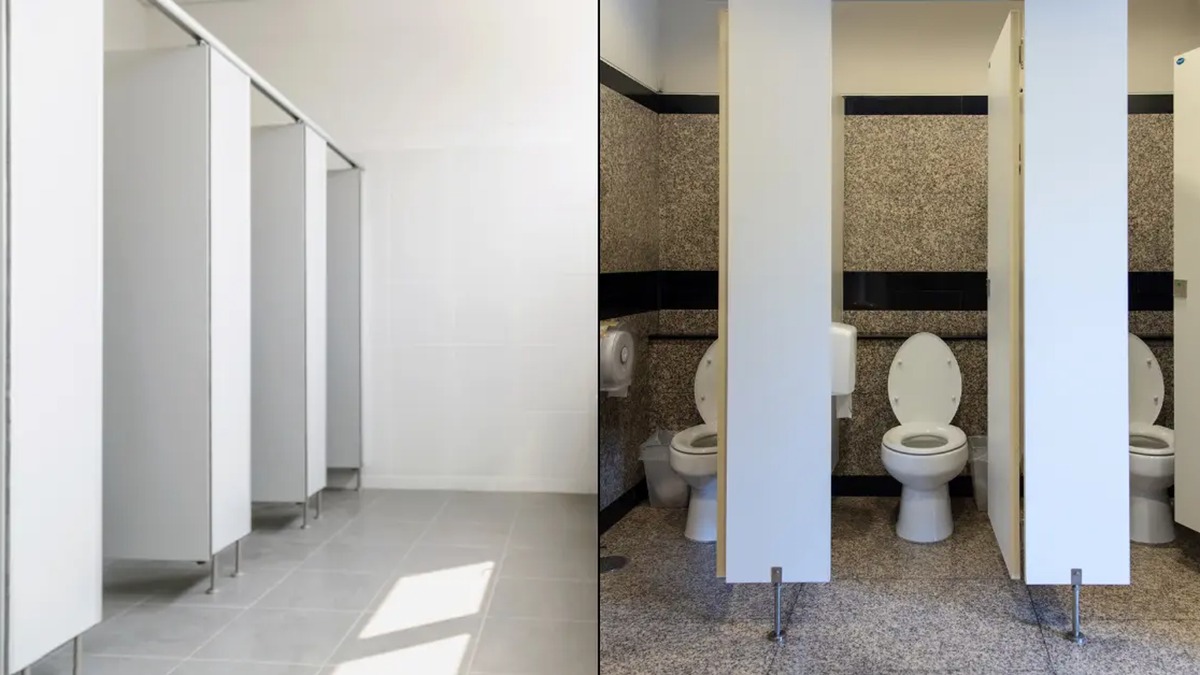HT6. Why Public Bathroom Doors Have Gaps at the Bottom – Practicality Over Privacy
Why do public bathroom stall doors have gaps at the bottom? It’s a common question many people ask, and while it may seem like a compromise on privacy, there are well-thought-out reasons behind this design. These gaps serve multiple purposes, balancing hygiene, safety, cost-effectiveness, and functionality.
In this article, we’ll explore why public bathroom doors are designed with these gaps, uncovering the practical benefits they provide and why they’re an essential feature in restrooms.
1. Improved Cleaning Efficiency
The gap at the bottom of bathroom stall doors makes it easier for janitorial staff to clean public restrooms quickly and effectively.
- Cleaning tools like mops and brooms can easily reach under the doors, allowing for a more efficient cleaning process.
- High-traffic restrooms benefit significantly as they require frequent cleaning, and this design speeds up maintenance.
For public spaces like malls, airports, and stadiums, this feature ensures cleanliness is maintained even during peak times.

2. Emergency Access
Accidents or emergencies can occur anywhere, including restrooms. The gap under the door plays a vital role in such situations.
- Emergency responders can assess the condition of someone inside without forcing the door open.
- This quick access could be lifesaving in medical emergencies, ensuring no unnecessary delays.
The gap ensures a level of accessibility that prioritizes user safety while maintaining the stall’s functionality.

3. Efficient Occupancy Management
The gap also helps users identify whether a stall is occupied, reducing unnecessary confusion or disruptions.
- A quick glance under the door lets others know if a stall is free, saving time.
- This efficiency is particularly helpful in busy restrooms, minimizing waiting times during peak hours.
This simple feature improves the overall flow of restroom usage, especially in crowded public spaces.

4. Discourages Misuse
Complete privacy in a public restroom might lead to unintended misuse of the space. The open-bottom design addresses this concern effectively.
- It discourages inappropriate behavior, such as vandalism or lingering for purposes other than restroom use.
- Increased visibility promotes a safer, more respectful environment for everyone.
By deterring misuse, the gaps contribute to better maintenance and safety in public restrooms.

5. Better Air Circulation
Restrooms need proper ventilation to control odors and ensure a fresh environment for users.
- The gaps at the bottom of stall doors facilitate airflow, dissipating unpleasant smells more effectively.
- Improved circulation also prevents stagnant air, making the restroom more comfortable for everyone.
Air circulation is a critical aspect of restroom design, and the open-bottom doors help maintain a pleasant atmosphere.

6. Cost-Effective Design
Shorter stall doors are more economical to construct and maintain.
- They use less material, reducing overall construction costs.
- They’re easier to install and repair, offering long-term cost savings for facility managers.
For large public restrooms with multiple stalls, these savings add up significantly, making it a practical design choice.

7. Easy Supply Assistance
Running out of toilet paper in a stall is a common inconvenience. The gap under the door makes it easy to resolve this issue.
- Supplies can be passed into the stall without requiring the door to be opened.
- This simple convenience ensures users can access essentials without unnecessary hassle.
8. Emergency Egress
In rare cases where a stall door lock malfunctions, the gap provides an escape route.
- Users can crawl out if they find themselves stuck inside, preventing them from being trapped.
- While not ideal, it’s a functional safety feature that offers peace of mind in unforeseen circumstances.
9. Maintaining Hygiene Standards

The gap contributes to overall cleanliness in more ways than one.
- Water or other liquids can drain out easily, preventing them from pooling inside the stall.
- This helps avoid slip hazards and keeps the stall floor drier and cleaner for users.
By promoting better hygiene, the design ensures a safer and more pleasant experience for everyone.
10. Promotes Social Awareness
The open-bottom design subtly reminds users that they are in a shared space, fostering a sense of social responsibility.
- People are more likely to clean up after themselves and be considerate of others.
- The design encourages quicker use, reducing unnecessary delays for those waiting.
This balance between privacy and practicality helps maintain harmony in public restrooms.
11. Balancing Privacy and Practicality
While the gaps may feel like a compromise on privacy, they serve to enhance the functionality of public restrooms in many ways.
- Complete privacy might seem appealing, but it comes at the cost of reduced airflow, higher maintenance, and limited emergency access.
- The current design strikes a balance, ensuring user safety, hygiene, and efficiency without excessive costs.
Conclusion
Public restroom design is more intentional than most people realize. The gaps at the bottom of stall doors may seem inconvenient at first glance, but they address critical needs such as cleaning efficiency, emergency access, and cost savings.
By balancing practicality and privacy, this design ensures public restrooms are functional, safe, and hygienic for all users. The next time you visit a public restroom, take a moment to appreciate how even small details, like the gap under the door, contribute to a better overall experience.
FAQs: Why Public Restroom Doors Have Gaps
Q: Why don’t public restrooms have full-height doors?
A: Full-height doors increase costs, reduce ventilation, and make cleaning or emergency access more difficult.
Q: Is the gap under the door only for cleaning purposes?
A: No, it also improves safety, airflow, and cost efficiency, while discouraging misuse.
Q: Does the gap compromise privacy?
A: While it reduces total privacy, the benefits in functionality, safety, and maintenance outweigh the drawbacks in public settings.












